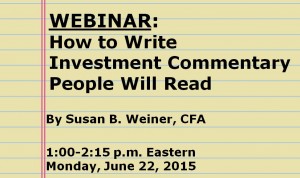Use personal stories to make your content pop!
“How can I make my content stand out, especially when I’m competing with companies with big names?” Participants in my writing workshops often ask me that question when I survey them as part of my preparation. You may grapple with the same challenge.
Your personal stories are unique and can make even the dullest topic come alive.
As an example, I share below my tips for snaring a seat on a commuter bus, which originally appeared in The Boston Globe. I don’t know anyone else who could have tackled the topic as I did.
Strategy is key, at the bus stop and in the market
By Susan B. Weiner
Most folks who know us think my husband and I work hard at our jobs in Boston’s financial services industry. And we do. But they haven’t seen true concentration until they have watched us jockey for seats on the express bus heading home during rush hour.
Our bus stop on Federal Street is a major hub of commuter activity. There’s ample room for six buses to pull up along the curb of the spacious plaza, which fronts the headquarters of one of Boston’s largest financial institutions. A big crowd clusters there during the evening rush, each weary worker hoping that his or her bus is the one gliding up to the curb.
It’s then that my investment management training comes into play. When our bus arrives, we don’t just board it. I’ve worked with my husband, Allan, to create a plan to achieve our goals, just as an investment counselor would work with clients. Short term, we want a double seat on the bus so we can talk side-by-side on the ride home. Our long-term goal? A happy marriage. Presumably our onboard talks about the day’s work will contribute to a close partnership.
Risk tolerance? High for achieving the first goal, low for the second. Assets? We’re both analytical and determined. Liabilities? We’re both nearsighted and short. We can’t count on spying our bus ahead of the, crowd. Nor do we have the bodies or faces to scare potential competitors out of our path. My curlyhaired, rosy-cheeked husband is more likely to crack jokes than to scowl.
As in investing, strategy is key. If l arrive first at the bus stop, I ponder the situation as intently as a securities analyst looks at her industry. My mission: to figure out where the next bus will pull up, so I can position myself. I want to be the first person on the bus, so I can grab a double seat, a prize almost as delectable as a double-digit increase in stock price.
When my husband arrives, he knows that he should look for me not at a fixed meeting spot, but where we reckon the next express bus for Waltham will open its doors.
It’s not easy to figure. That downtown corner is the assembly point for half a dozen express buses that travel the Massachusetts Turnpike. The buses come in no particular order. Some financial commentators complain that sector rotation in the stock market is vicious—financial stocks win one week, consumer staples another. But they haven’t seen anything like the random nature of bus arrivals. It’s Newton Corner…Newton Corner…Brighton…Watertown…Riverside. Often it feels as if the Waltham bus I’ve placed my stake on doesn’t come often enough.
The buses pull in at different spots along the curb. Sometimes they’ll stop only to roll on their “out of service” signs and cut their engines, because they’re early. Just as stock prices can’t rise without a catalyst,a bus driver can’t leave ahead of schedule. At least not without special dispensation from a dispatcher.
On occasion, I catch a clue from the dispatcher as he waves a hand to direct a bus. A dispatcher’s gesture can move the crowd, just as an upgrade from an influential analyst might spark a run-up in a stock.
Other times, there’s only one opening on the block, so the bus’s destination is obvious. On other occasions, I’ll analyze the bus as it angles toward the curb. I think of that as the bus world’s equivalent of technical analysis of stocks—both involve the velocity and directional pattern of the subject.
But just when I think I’ve perfected my analytical skills, a bus driver will fake me out by parking in an unexpected spot. It’s as unpleasant as a negative earnings surprise by a company that’s overweighted in my portfolio. As they say in mutual fund advertisements, “Past performance is no guarantee of future returns.”
When Allan finally shows up at the bus stop, there’s only time for a quick kiss. “I’ll wait behind this bus. You go back there,” he’ll say. We split up to improve the odds of getting first crack at seats together. My husband calls this “diversifying our assets.” We both know that diversification increases rewards while reducing risk.
“There it is!” I’ll yell sometimes, if enthusiasm gets the best of me upon spotting my quarry. But just as the highest rewards go to the first investors in a stock gathering momentum, the best seat goes to the bus analyst who discreetly signals, using a raised hand or a mere wink.
Allan tries to join me without alerting our fellow commuters. Once the bus is spotted, others will pile in, as investors piled into the dot-com stocks of the 1990s. I persevere. I’ve become adept at twisting my body to fit into openings without jostling my competitors. Sometimes I reach the hard blue plastic seats before my husband can get on the bus. Like any investor, I work hard to lock in my gains. Placing a bulging briefcase on the seat next to me will often be enough. Otherwise, I repeat my mantra to those who ask if the seat is taken: “My husband is sitting there; my husband is sitting there.” Soon enough he’ll appear.
Actively managed stock portfolios struggle to beat the performance of the Standard & Poor’s 500 index. The level of competition for double seats at rush hour runs just as high. It feels terrific when Allan and I succeed. I’m flushed with excitement as my husband drops happily into the seat next to me. Finally, I can relax.
Image courtesy of Adam Hickmott at FreeDigitalPhotos.net



